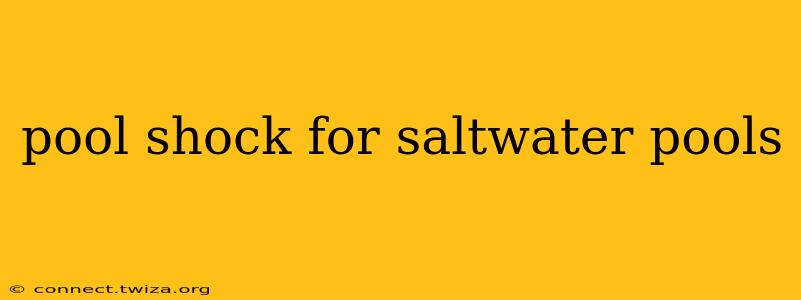Maintaining a sparkling clean and healthy saltwater pool requires diligent care, and understanding the role of pool shock is crucial. While saltwater pools are self-sanitizing to a degree, thanks to the salt chlorine generator, they still need periodic shocking to combat organic contaminants and maintain optimal sanitation levels. This guide will delve into the specifics of using pool shock in saltwater pools, addressing common questions and concerns.
What Kind of Pool Shock Should I Use for My Saltwater Pool?
The type of shock you use for your saltwater pool is crucial. While you can use chlorine-based shock (calcium hypochlorite or dichlor), non-chlorine shock (potassium monopersulfate) is generally preferred for saltwater pools. This is because chlorine-based shocks can contribute to higher calcium hardness levels, potentially leading to scaling and other issues in your saltwater system. Non-chlorine shock, while slightly more expensive, works effectively without adding to the calcium levels already managed by your salt system.
How Often Should I Shock My Saltwater Pool?
The frequency of shocking your saltwater pool depends on several factors, including:
- Weather: Hot, sunny days increase algae growth and organic contamination, requiring more frequent shocking.
- Bather Load: Higher bather loads introduce more contaminants, necessitating more frequent treatments.
- Pool Use: Frequent use generally means more frequent shocking.
- Water Testing: Regular water testing is crucial to monitor chlorine levels and identify the need for shock treatment.
A good rule of thumb is to shock your saltwater pool at least once a week, preferably after heavy use or periods of inclement weather. However, consistent water testing is paramount. If your free chlorine levels drop significantly, it's time to shock.
Is Non-Chlorine Shock Better for Saltwater Pools?
As mentioned above, non-chlorine shock (also known as potassium monopersulfate or MPS) is often the preferred choice for saltwater pools. It effectively oxidizes contaminants without adding to the already present chlorine or calcium levels. While slightly more expensive, the long-term benefits of avoiding potential scaling and maintaining balance in your pool's chemistry typically outweigh the added cost.
Can I Use Chlorine Shock in My Saltwater Pool?
Yes, you can use chlorine shock in a saltwater pool, but it's generally not recommended as the primary method. While effective at oxidizing contaminants, chlorine-based shock (calcium hypochlorite or dichlor) increases the calcium hardness of your water. High calcium hardness levels in a saltwater system can lead to scale buildup on your pool equipment, reducing its lifespan and efficiency. Use chlorine-based shock sparingly, if at all.
What Happens if I Over-Shock My Saltwater Pool?
Over-shocking your pool can lead to several undesirable outcomes:
- High Chlorine Levels: This can irritate skin and eyes, damage pool surfaces, and potentially harm the chlorine generator cell.
- Cloudiness: High chlorine levels can sometimes temporarily cloud the water.
- Waste of Chemicals: Over-shocking is simply inefficient and wasteful.
Always follow the manufacturer's instructions on the pool shock packaging and test your water regularly to avoid over-shocking.
How Much Pool Shock Should I Use for My Saltwater Pool?
The amount of shock needed depends on the size of your pool. Always refer to the specific instructions on the product label. Using too little is ineffective, while using too much can have negative consequences. Accurate pool volume calculation is crucial for precise shocking.
In conclusion, maintaining a balanced and clean saltwater pool requires a comprehensive approach that includes regular water testing and appropriate shock treatment. By understanding the nuances of using pool shock in saltwater pools and prioritizing non-chlorine options, you can ensure your pool remains a refreshing and enjoyable oasis. Remember always to consult with a pool professional for personalized advice tailored to your specific pool and its needs.
